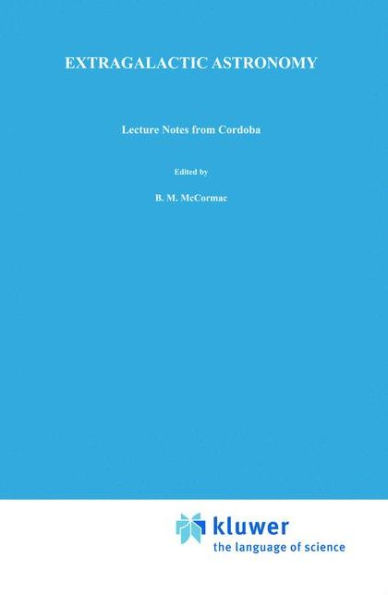Extragalactic Astronomy: Lecture notes from C�rdoba
This book is an outgrowth of the notes made for the semester lectures on 'Problems of Extragalactic Astronomy' given almost annually during two decades at the Ob- servatorio Astronomico of the Universidad de Cordoba. Shorter versions were also given at La Plata, Santiago de Chile, Sao Paulo, Rio de Janeiro and Paraiba. E. Scalise made a Portuguese language version of the notes and encouraged me to publish them; although my friend J. Kleczek is to be blamed for the idea of this book. Not every subject on Extragalactic Astronomy has been touched in this book: instead I have followed those which interested me during 25 years of professional practice in this part of the world. I acknowledge helpful suggestions from M. Pastoriza and G. Carranza, the com- prehension of Director L. Milone, and the collaboration of the staff of the Observa- tory in Cordoba. R. Tschamler's humor and wit made light the task of producing the English version and M. Pizarro's devotedness produced the edited MS. To both of them I am in deep gratitude. "A book is published out of necessity, otherwise the author would spend his entire life polishing the originals" was the answer given by J. L. Borges to an inquisi- tive journalist. These words explain why this book is so different from the lecture notes, and also from the book I was hoping for. I thank B. McCormac and the D. Reidel Publ. Co. for my salvation from Borges' inferno.
1134468328
Extragalactic Astronomy: Lecture notes from C�rdoba
This book is an outgrowth of the notes made for the semester lectures on 'Problems of Extragalactic Astronomy' given almost annually during two decades at the Ob- servatorio Astronomico of the Universidad de Cordoba. Shorter versions were also given at La Plata, Santiago de Chile, Sao Paulo, Rio de Janeiro and Paraiba. E. Scalise made a Portuguese language version of the notes and encouraged me to publish them; although my friend J. Kleczek is to be blamed for the idea of this book. Not every subject on Extragalactic Astronomy has been touched in this book: instead I have followed those which interested me during 25 years of professional practice in this part of the world. I acknowledge helpful suggestions from M. Pastoriza and G. Carranza, the com- prehension of Director L. Milone, and the collaboration of the staff of the Observa- tory in Cordoba. R. Tschamler's humor and wit made light the task of producing the English version and M. Pizarro's devotedness produced the edited MS. To both of them I am in deep gratitude. "A book is published out of necessity, otherwise the author would spend his entire life polishing the originals" was the answer given by J. L. Borges to an inquisi- tive journalist. These words explain why this book is so different from the lecture notes, and also from the book I was hoping for. I thank B. McCormac and the D. Reidel Publ. Co. for my salvation from Borges' inferno.
219.99
Out Of Stock
5
1

Extragalactic Astronomy: Lecture notes from C�rdoba
247
Extragalactic Astronomy: Lecture notes from C�rdoba
247
219.99
Out Of Stock

Product Details
| ISBN-13: | 9789027713216 |
|---|---|
| Publisher: | Springer Netherlands |
| Publication date: | 05/31/1982 |
| Series: | Geophysics and Astrophysics Monographs , #20 |
| Edition description: | 1982 |
| Pages: | 247 |
| Product dimensions: | 7.01(w) x 10.00(h) x 0.24(d) |
From the B&N Reads Blog
